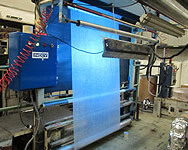Web Handling Equipment: Why Do We Use It?

The more you know about web handling equipment—as well as the industries that take advantage of it—the easier it will be to handle. Below, our team at Conversion Technologies International covers not only what this equipment applies to and which industries rely upon it, but the options you have when it comes to managing these processes externally or internally.
What Does Web Handling Equipment Do?
You may have already come into contact with web processing manufacturing without realizing it. Conversely, you may have a basic idea of what web manufacturing involves. The reality is that web manufacturing encompasses a few different processes. Among them are:
- Laminating
- Coating
- Plating
The idea behind any kind of web manufacturing is that the web is transferred at uniform speeds for the sake of consistency. At the same time, one cannot disturb the substrate involved and you must maintain the surface without defects. For the sake of consistency, the line speed of the web processing is among the biggest components to consider.
Every web manufacturing process involves feeding and controlling the webbing through web handling equipment. We accomplish this with strict control in order to maintain the consistency of the final results. Web tension control is key—the web can’t be too lax, but at the same time it must not be so tight that damage occurs. If we don’t manage the tension, the final product is more at risk of developing damage or defects. When you’re left with a damaged or defective productive, you’re left with waste—and ultimately, the less of both time and money.
What is a Web Roll?
Delving into the specifics surrounding web manufacturing and web handling equipment—what is a web roll? The web you’re working with is always going to be a flexible, stretchy material. When you work with that web within a web roll, that webbing is wound around a rigid core. This stabilizes the webbing and makes it easier for you to maintain tension, while controlling the amount of web that we feed into a machine.
As we feed web through the machinery, it’s stabilized through the rollers. Typically, you’ll see rollers made of carbon fiber, aluminum, steel, and stainless steel. Of course, keep in mind that there are alternative rollers available as well—idler rollers. These rollers are not meant for tension so much as they’re meant for support, and they spin at the same speed as the web. We accomplish this through low friction bearings.
If we purely use the roller for support, you may utilize dead shaft rollers. A dead shaft roller has an outer shell that spins while the shaft itself remains stationary. Conversely, a live shaft roller has a rigid outer roller surface, while the assembly supports itself through a bearing mounted on the machine’s frame. Through this setup, both the outer shell and the shaft spin. This is commonly seen with driven rollers, heating and cooling rollers, and certain other process rollers.
Which Industries Rely Upon Web Processing?
A wide variety of industries rely upon web handling equipment and web processing. Textile manufacturing is highly reliant on web processing—which means that clothing and fashion industries in general connect back to this process. Additionally, we manufacture paper products through web processing—this includes magazines, books, and newspapers.
Similarly, we manufacture different appliance parts via web handling equipment. We manufacture products as complex as aircrafts and as seemingly simple as boxes with web processing. Plastic sheeting, tape, floor coverings, flooring, roofing, and other products are also commonly made through web processing.
What’s Next?
It’s clear that web processing is not a “niche” manufacturing procedure. The question is, how do you ensure that it’s handled properly for your business? The key for many business owners is working with a third party that can handle the process efficiently for you. When working with a third party manufacturer, you’re able to save money that you otherwise spend on permanent equipment, raw materials (which a connected manufacturer can sometimes acquire more affordably) and experienced employees.
Finding a reliable, responsible third party manufacturer might seem intimidating at first. However, if you reach out to other business owners for recommendations and read reviews online, you’re off to a great start. A good third party manufacturer doesn’t need to be near you to be valid—CTI, for example, can work with far-reaching clients. What’s most important is that you trust their experience, as well as the quality of their products and their ability to work with you.
How do you ensure that a third party manufacturer delivers products at the quality you need? You consult with them first! That’s why CTI offers consultations for business owners as they consider working with us. We want to make sure that you feel as comfortable with our services as possible, and a part of that process involves making sure that you’re involved in a pilot run and prototyping.
If you’re curious about web handling equipment and processing—and having your process handled by a third party—we’re ready to help. Call CTI at 419-924-5566. Additionally, you can contact us online. You don’t have to navigate this alone. Let the experts assist, whether that means consulting or—ultimately—processing.
- << < Previous Post
- 1
- 2
- ...
- 47
- ...
- 241
- 242 Next Post > >>

